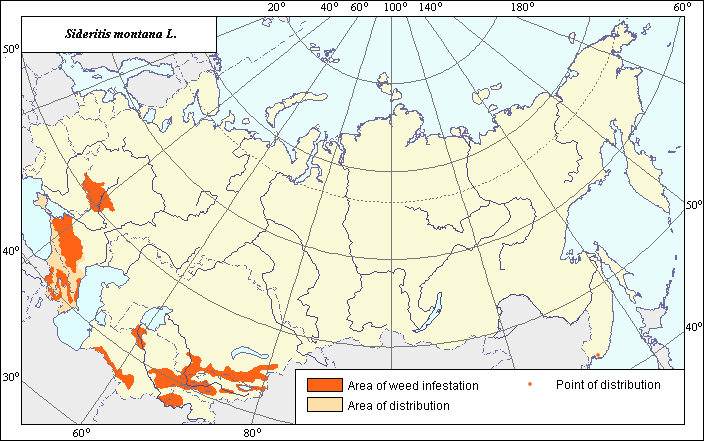Weeds
Area of distribution and weediness of Sideritis montana L.
 Object description Download GIS-layers
Object description Download GIS-layers
Authors:
Object specialist T.D. Sokolova,GIS-specialist I.A. Budrevskaya.
Date of creation:
20.09.2004Scale:
1:20 000 000.Accuracy of map:
Map was created based on maps of natural scale 1:5 000 000 and on literature data.Projection:
"Alber's Equal Area Conic" USSR, 9, 1001, 7, 100, 0, 44, 68, 0, 0.Basic contents:
Vector map. Area of species distribution is shown by polygons, and sporadic distribution by points. Zones of weediness are shown by polygons.Accuracy of classifier:
The weed area is subdivided into two zones, one representing species distribution, and the second where species is considered a serious weed. Points represent locations where sporadic occurrence has been reported. The zone of weediness was established according to the criteria of occurrence and abundance of this species base on the work of Tanskii et al. (1998). With the limits of this zone S. Montana is characterized by having a 25-50% frequency of occurrence and 2 points of abundance.Method of map production:
Published literature was reviewed, including Atlases, monographs and papers. Occurrence data were obtained from herbarium specimens, floras, monographs and papers. The area of main distribution of S. montana was determined according to the following sources: Grossgeim (1967), Nikonov (1975), Geideman (1954), Visyulina (1970), Rubtsov (1972), Aleksandrova et al. (1975), Maevskii (1954), Elenevskii et al. (2001), Galushko (1980), Takhtadzhyan (1987), Karyagin (1957), Ulyanova (1989), Vvedenskiy (1960, 1961), Nikitin (1954, 1979), Vasilchenko (1953), Pavlov (1964). Limits of the zone of weediness were established according to Nikitin (1983), and adjusted according to the data on abundance and frequency of the species occurrence, which are taken from below-mentioned references, and adjusted to the limits of arable lands (Koroljeva et al., 2003). According to Nikitin (1979, 1983), S. Montana does not heavily infest grain crops in the steppe zone of the European part of the former USSR and in Central Asia. According to data of Ulyanova (1989) S. montana infests cotton crops in all cotton-growing regions of Central Asia. Data were then compiled through scanning and geo-referencing to develop a composite vector map. The biologist, together with the GIS specialist, drew a composite weed distribution area based on compiled data.Reference citations:
Aleksandrova K.I., Barabash G.I., Kamaeva G.M., Kamyshev N.S. 1975. Keys to weeds of Central Chernozem area. Voronezh: Voronezh University. 276 p. (In Russian)Elenevskii A.G., Radygina V.I., Bulanyi J.I. 2001. Keys to vascular plants of the Saratov region (the right bank of the Volga). Moscow: Moscow pedagogical university. 278 p. (In Russian)
Galushko, A.I. 1980. Flora of Northern Caucasus. V. 3. Rostov-na-Donu: Rostov University. 328 p. (In Russian)
Geideman T.S. 1954. Keys to plants of Moldavian SSR. Moscow-Leningrad: AN SSSR. 468 p. (In Russian)
Grigoryevskaya, A.Ya. 2000. Flora of Voronezh city. Voronezh: Voronezh University. 200 p. (In Russian)
Grossgeim, A.A. 1967. Flora of the Caucasus. V. 7. Leningrad: Nauka. 896 p. (In Russian)
Karyagin, I.I., ed. 1957. Flora of Azerbaijan. V. 7. Baku: AN Az. SSR. 648 p. (In Russian)
Kharkevich S.S., ed. 1995. Vascular plants of the Russian Far East. V. 7. Saint Petersburg: Nauka. 395 p. (In Russian)
Koroljeva IE, Vilchevskaya EV, Ruhovich DI. 2003. Digital Arable Land Map. Laboratory of Soil Information of the Dokuchaev Soil Institute, Moscow, Russia [Based on: Yanvareva LF. (ed.), Martynjuk KN., Kisileva NM. 1989. Map of Land Use, Faculty of Geography, Moscow State University, Moscow, Russia.].
Maevskii, P.F. 1954. Flora of the middle zone of the European part of the USSR. Moscow-Leningrad: Selkhozgiz. 912 p. (In Russian)
Nikitin, V.V., ed. 1954. Flora of Turkmenia. V. 6. Ashkhabad: Turkmen branch of AN SSSR. 404 p. (In Russian)
Nikitin V.V. 1979. Geographical distribution of the most important weed species of the USSR and their dynamics. Botanicheskii zhurnal, 64(7): 943-949. (In Russian)
Nikitin V.V. 1983. Weed plants in the flora of the USSR. Leningrad: Nauka. 454 p. (I Russian)
Nikonov A.A., ed. 1975. Weed plants of the Stavropol Territory. Proceedings of Stavropol research institute of agriculture. Stavropol: Stavropol research institute of agriculture. 292 p. (In Russian)
Pavlov, N.V., ed. 1964. Flora of Kazakhstan. V. 7. Alma-Ata: AN Kazakh SSR. 498 p. (In Russian)
Rubtsov N.I., ed. 1972. Keys to higher plants of the Crimea. Leningrad: Nauka. 552 p. (In Russian)
Takhtadzhyan, A.L., ed. 1987. Flora of Armenia. V. 8. Yerevan: AN Armenian SSR. 420 p. (In Russian)
Tanskii V.I., Levitin M.M., Ishkova T.I., Kondratenko V.I. 1998. Phytosanitary diagnostics in integrated managemant of cereals. In: Novozhilov K.V., ed. Compendium of methodical recommendations in plant protection. St. Petersburg: VIZR. 5-55 p. (In Russian)
Ulyanova T.N. 1989. Field weed plants of cotton in the USSR. In: Agaev M.G., ed. Catalogue of VIR world collection. Issue 499. Leningrad: VIR. 40 p. (In Russian)
Vasilchenko I.T., ed. 1953. Weed plants of Tajikistan. V. 2. Moscow-Leningrad: AN SSSR. 323 p. (In Russian)
Visyulina O.D., ed. 1970. Weeds of the Ukraine. Kyiv: Naukova dumka. 508 p. (In Ukrainian)
Vvedenskii, A.I., ed. 1960. Flora of Kirghiz SSR. Identification book on plants of Kirghiz SSR. V. 9. Frunze: AN Kirghiz SSR. 214 p. (In Russian)
Vvedenskii, A.I., ed. 1961. Flora of Uzbekistan. V. 5. Tashkent: AN Uz. SSR. 668 p. (In Russian)

